Agile or traditional? If you are weighing the pros and cons of both project management methods, there is a good alternative. Work with both methods by using hybrid project management. This article explains the best scenarios for using this hybrid approach. An example is used to illustrate how hybrid project management methodology is put into practice. In the following sections, you will learn:
- What is “hybrid project management”?
- Which scenarios are best suited to hybrid project management?
- Roles and processes in the traditional project lifecycle
- By contrast: agile work methods
- Resource and capacity planning in agile projects
- Hybrid project management: optimally combining the two methods
- Hybrid project management: example
- Traditional and agile methods within a company: using both methods
- Combining both methods within a single project
- Agile, traditional or hybrid approaches in multi-project management?
- Conclusion and recommendations
What Is “Hybrid Project Management”?
A hybrid approach to project management thereby integrates the various methods (such as PMI and Scrum) or the use of diverse elements from various methods (such as User Stories from Scrum with the V model XT software specifications).
Which Scenarios Are Best Suited to Hybrid Project Management?
Many organizations function in an environment in which traditional processes have evolved over time and compliance is required with broad obligations and required standards. For projects, this means that there is a focus on choosing methods that clearly define the plans and project goals and require that everything is documented. Or methods are prescribed by an external source, such as a regulatory authority.
However, times are changing. As software continues to play an increasingly important role in hardware products, agile methods ‒ with their iterative processes and shifting objectives from sprint to sprint ‒ have become increasingly popular.
Combining traditional methods for some of the subprojects with elements of the agile methodology (such as Scrum) lets organizations take advantage of the best of both worlds to find the solutions best suited to their individual needs. This can enhance the project’s benefits by, for example, achieving better results, reaching the goals faster, or minimizing expenses.
Note: The PMI study “The Drivers of Agility” found that companies operating with a high degree of agility bring significantly more projects to a successful conclusion than those that do not. Of the companies exhibiting a high degree of agility, 68% used agile methods, 71% predictive, and 72% used a hybrid methodology. Among the companies exhibiting a low degree of agility, only 41% used agile methods, 45% predictive, and 51% hybrid methods.
Roles and Processes in the Traditional Project Lifecycle
- Project sponsors
- A project manager
- Several team leaders
- Team members
- A Project Management Office (PMO)
One or more project sponsors define the overall goal. The objectives are then to narrow these goals down to actual targets, with the expectation that these will be met. It is important to determine what skill sets are needed and when and then find out when these will be available.
The project is then prioritized and considered when resources are allocated. Team members are different for each project, as each member is chosen based on the skill sets needed for that particular project. The team leaders from the various departments need to see what resources they need to handle their daily operations to find out what resources can be made available to the project.
As the project progresses, some deadlines may need to be modified and other elements changed, but the focus should always be on ensuring that the specified goals are met by the given deadline. Resources can be withdrawn from lower-priority projects and reassigned to top-priority projects so that team members devote most of their energy to those projects having the highest priority.
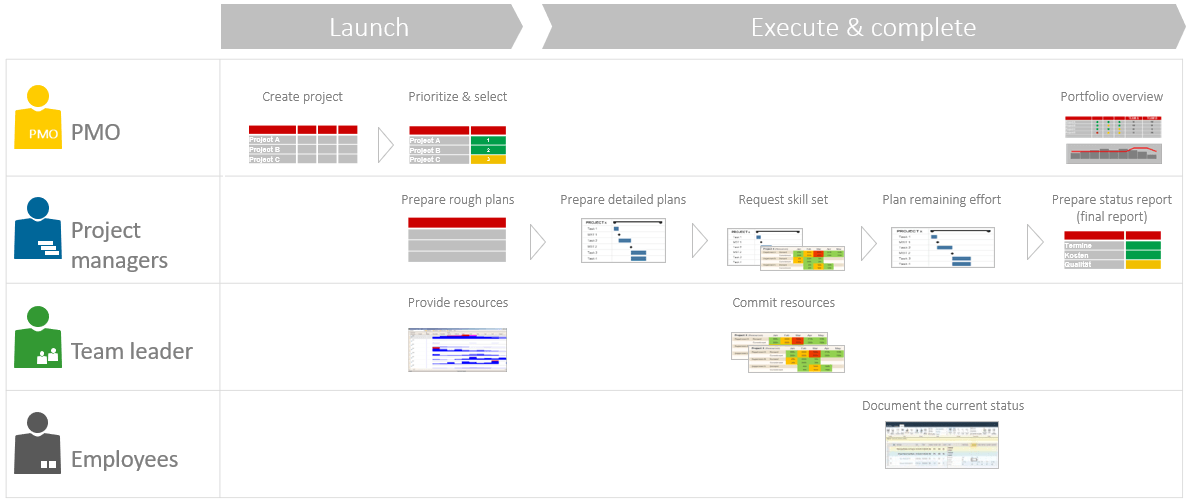
It is important to keep an overview of all the current and new projects and their resource utilization. In addition, close coordination is required to optimize resource utilization with regard to the latest requirements and circumstances.
Any changes to the project are carefully tracked and, together with the sponsors and / or end customer, evaluated with regard to added value and additional cost as compared to the original specifications. Status reports are prepared to show progress on the delivery of existing orders. Detailed schedules are created in the form of Gantt charts and milestone trend analyses. Risk analyses, with recommendations for avoiding these risks or minimizing their effects, may also be included.
The final result is generally some form of acceptance document that compares the delivered result with the original order. If there are deficiencies, these will be listed in the document and subsequently corrected. Sometimes these deficiencies are minor and can be accepted, but sometimes 100% compliance with the original specifications is required because, for example, the deliverable is a bridge that must stand or a crash test that must be withstood.
In the end, there is a final meeting involving the team members, project managers and sponsors to discuss and document the lessons learned so that future endeavors may benefit.
This is a good time to ask yourself what can be done better the next time. Achieving goals and allocating the required resources is completely normal and necessary, right? Yes, if the goals are absolutely clear and these are the right measures for achieving those goals, then the traditional approach is the best one.
However:
- What if you are expected to deliver results that can be obtained in several ways?
- What should you do if new insights and technologies become available during the project?
- How can you integrate these into the existing project plans to deliver a better solution?
- Would it not be great if there was some way to get the sponsors, customers, and users to all agree to these changes without risking non-conformance with the specifications?
Sometimes it is just not possible to clearly define what the deliverable should be because those involved themselves do not know exactly what they want or need. Have you ever not realized you were hungry until the scent of food made you crave a particular dish? Suddenly, you knew exactly what you wanted.
Another interesting read: Agile project management, traditional or hybrid?
By Contrast: Agile Work Methods
Agile approaches are much more common today, especially at the product development stage in software development or other similar areas. This often applies to cloud solutions, which must provide uninterrupted service.
Increasingly, the approach is used in other high-tech and complex environments as well. The traditional approaches described above are just not suitable in cases like this.
Therefore, it has become prevalent, as in agile approaches, for a fixed team to develop iterative versions of a product while the users are already using the product on a daily basis. After all, the users also want to see ongoing progress.
A team is often put together only once and then continues to live for and with this software, just as other teams do with their products. The teams are rarely ever reorganized.
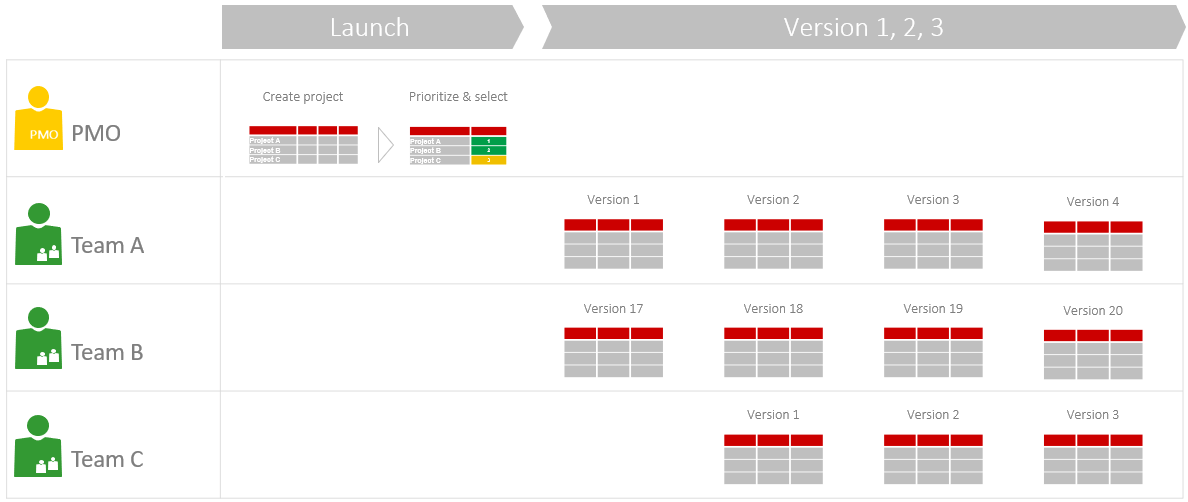
Looking at the roles in agile methods (such as Scrum), we can identify the following:
The Product Owner
- Makes all the decisions regarding the product
- Prioritizes and maintains the backlog
- Is constantly available
The Scrum Master
- Manages the process
- Removes impediments
When it comes to resource planning, the following applies: strategic and tactical planning is also necessary for agile teams. Staff is needed for ongoing projects, new staff must be trained, etc.
You might also be interested in Agile IT Project Management at OEMs.
Remember that no one is permanently available 100% of the time. Plan for absences due to vacations, etc. What is the best way to handle resource planning and capacity planning?
Resource and Capacity Planning in Agile Projects
Agile methods offer an advantage in resource planning: their fixed product and project teams, as well as the fixed cadence, make overall planning and the shifting of staff between projects much easier.
Our tip: Take particular care to find a shared rhythm across projects and thus achieve harmonization. This makes it much easier for staff to shift from one project to another.
Agile teams are mostly self-organized and have the experience necessary to estimate the effort involved. This starts with a rough estimate that becomes more detailed in the course of the project. The teams report when something has been completed and give feedback in reviews and retrospectives.
Together with the product owner, they gather stakeholder feedback in review meetings.
Kick-off meetings are no longer required in agile environments.
Learn more about Project Resource Management.
Regular sprint planning, reviews, and retrospectives, on the other hand, are mandatory.
In addition, the development team meets daily to discuss progress with regard to the Sprint Goal.
The only remaining targets can be found in the Product Backlog or the Sprint Backlog as a subset for each sprint. If something is not documented in the backlog, it will not be done.
Communication with the stakeholders is not only through the reviews but also via public boards with Sprint or product burn down charts. This is why the traditional reports with their schedules, costs, and status are superfluous at best.
Yet, what may be missing is a meaningful multi-project overview.
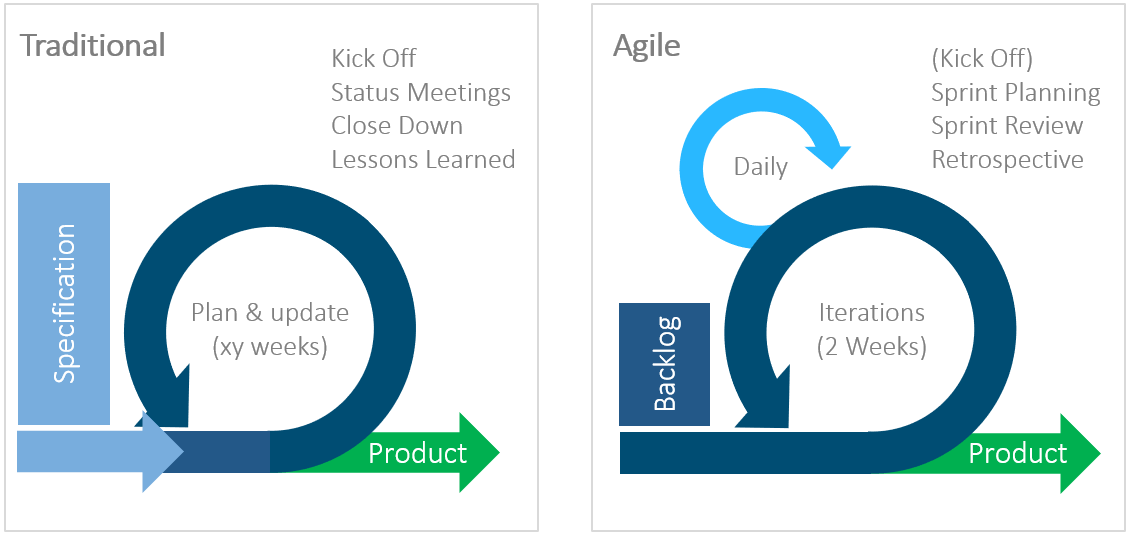
Hybrid Project Management: Optimally Combining the Two Methods
How can you combine these two different worlds?
There are many approaches to introducing hybrid methods:
- Concurrent Use of Traditional and Agile Methods:
- Some business units always use traditional methods (e.g. consulting). Others always use agile methods (e.g. software development).
- Some projects use a traditional approach, others an agile one.
- Some parts of a project are implemented in a traditional way, other parts using agile methods.
- High-level planning employs a traditional approach, detailed planning an agile one.
- Combining Traditional and Agile Methods in a Single Project:
- In traditional projects:
- Closer coordination with users and more frequent, implementable intermediate results
- Regular meetings to discuss progress (not necessarily daily – once a week is a good start)
- Retrospectives (Lessons Learned) after each status update meeting, not just at the end
- There is a fixed team for the entire duration of development
- In agile projects:
- Scrum Masters also serve as project managers in the traditional sense
- A Backlog is created for each project phase rather than as a specification for the overall product
- Project planning is synchronized with the sprint lengths
- Projects are planned using phases and milestones – at a higher level than the sprints and in addition to them
- There are status reports and milestone trend analyses for management and for the stakeholders
- (By the way, many agilists are unhappy with the latter two examples, as they can water down the basic agile principles).
A general note: Are the customer’s requirements uncertain and unclear? Is the approach to a solution for the project still unclear and new? Agile methods are particularly well-suited in this case, as they were developed for exactly this type of situation.
Our tip: Look at the first option in the above list. Having some business units use traditional approaches while others use agile ones is probably one of the most seamless and common implementations of hybrid project management. This usually ensures high process stability.
Hybrid Project Management: Example
For customer consulting projects, you always use traditional methods whereas the endeavors focusing solely on product development follow agile principles. What to bear in mind: customer wishes have to be aligned between the business units.
This means that the sales department must have a say in the release planning.
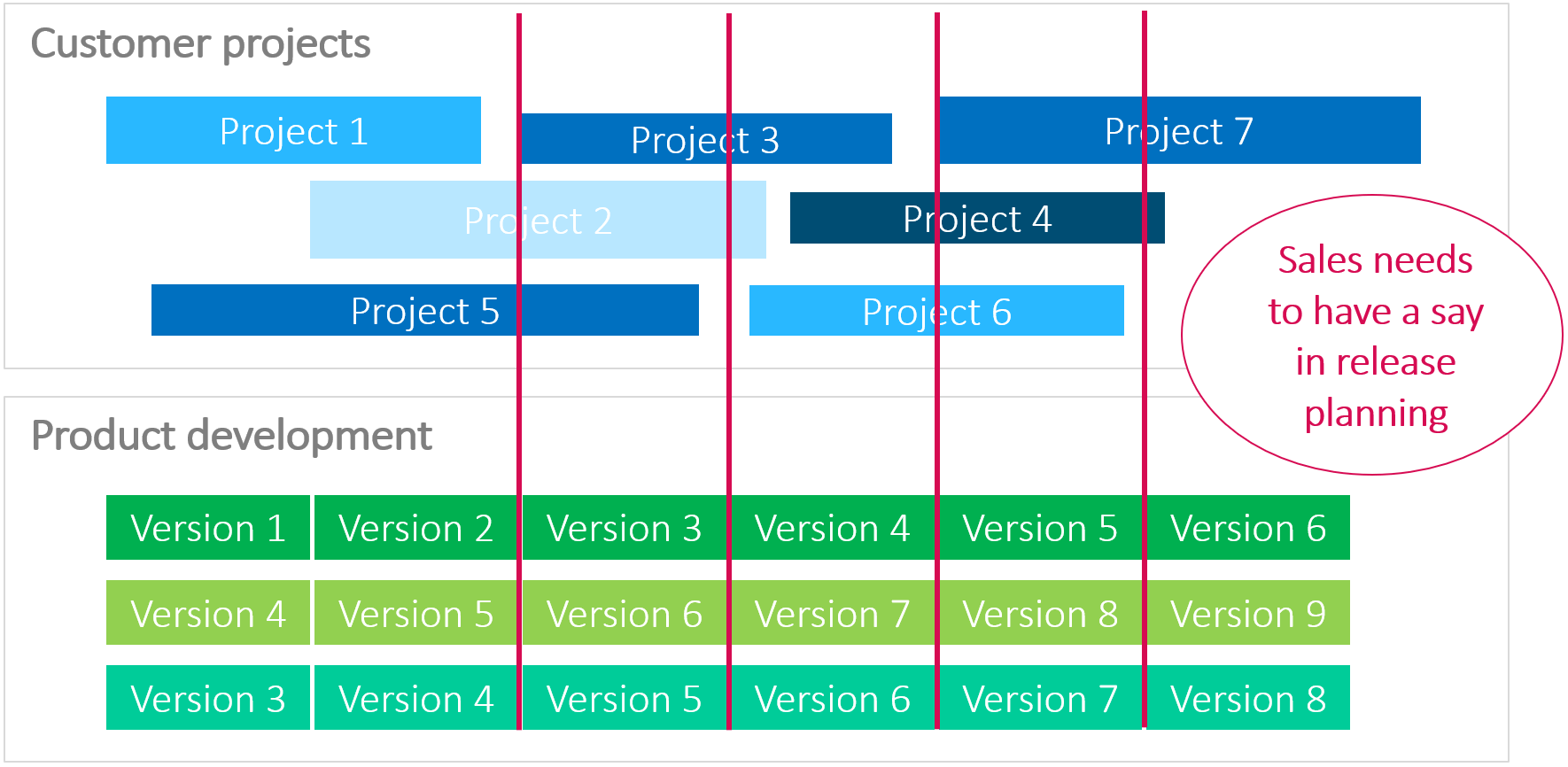
Traditional and Agile Methods within a Company: Using Both Methods
Please note: Frequent changes between traditional and agile approaches from one project to the next pose a risk to the process stability.
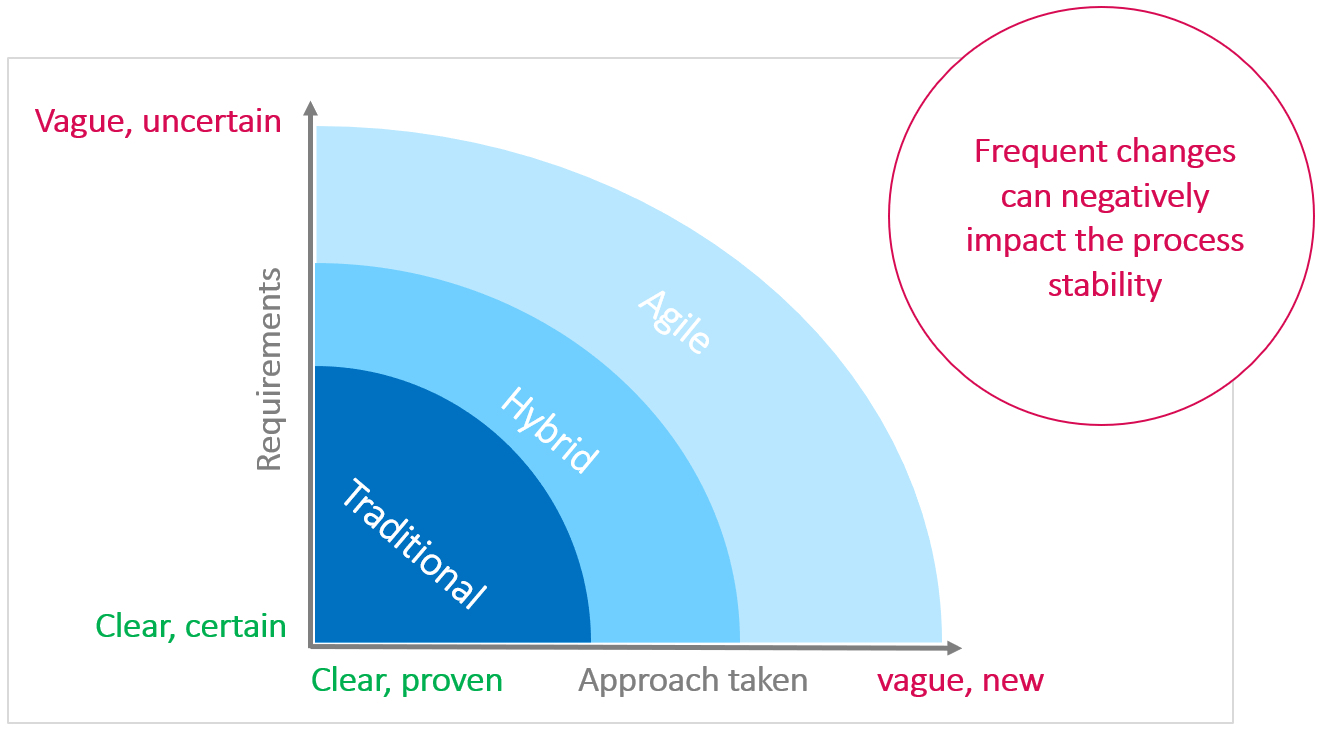
Therefore, another option is to combine methods in a meaningful way – rather than changing between methods in projects. To give you an example:
- Traditional concept, specification and implementation for the hardware
- Agile software development
- Traditional acceptance test
or:
- Agile concept and specification
- Traditional implementation and acceptance test
or:
- Traditional methods for everything up to the integration
- Agile integration
Our tip: If you use hybrid approaches within a single project, follow this proven approach: use agile methods for unclear parts of the project while using traditional methods for the clearer parts.
Combining Both Methods within a Single Project: Using Traditional Methodology for Hogh-Level Planning and Agile Methodology for Detailed Planning
Another approach has been proven successful for using hybrid methods in the same project:
- Use traditional methods for high-level planning as a kind of superstructure.
- Add an iterative element afterward using agile work methods.
This approach lets you continue to plan milestones and status meetings. While at the same time benefiting from the advantages of agile work methods.
Making the meeting frequency rhythmic also will minimize friction and the general coordination effort – which ultimately increases productivity.
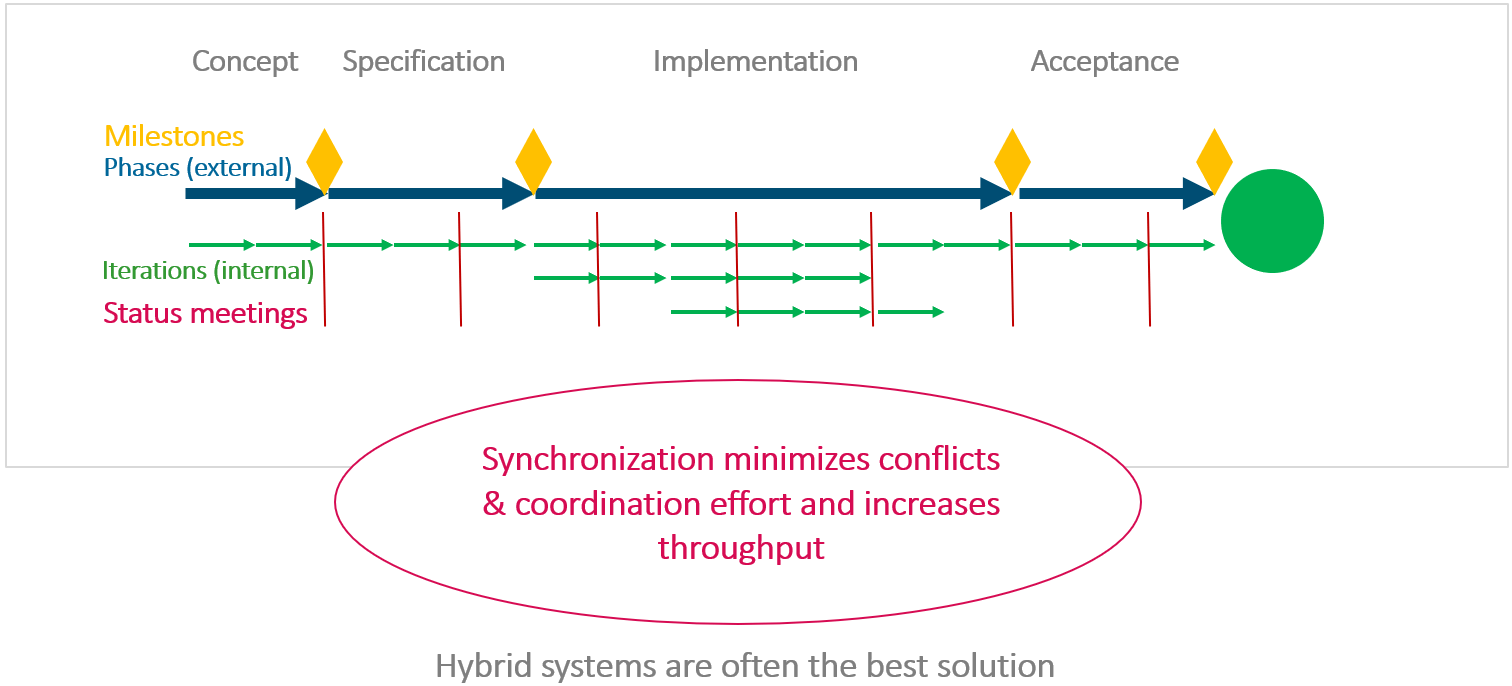
A survey on hybrid PM conducted during one of our webinars held in April 2018 involving 256 respondents (multiple answers possible) revealed that:
- 11% of the participants carried out their projects according to the defined methods of that business unit
- 41% decided the method project by project
- 40% chose the method based on the project situation
- 41% did their high-level planning with traditional methods and used agile ones for their detailed planning
- 18% were still unsure
Our tip: Separate the methods clearly, depending on the business unit. This will provide the highest process reliability. It is usually a good way to get started.
Agile, Traditional or Hybrid Approaches in Multi-Project Management?
Multi-project management will always require an overview of the status, necessary decisions, and delivery dates.
- Status
- Required decisions
- Delivery deadlines
Problems concerning the project status need to be quickly and clearly discernible (e.g. with the aid of a red traffic light symbol).
This is another difference. In typical (multi-) project environments, traditional methods will always be necessary. In the course of product development for “small-scale projects” from version to version, it is a little different. They can be planned with agile methods without any problems.
As agile environments do not provide methods for multi-project management, further questions are unnecessary.
Conclusion and Recommendations
This article has introduced you to ways in which hybrid project management – a mix of agile and traditional approaches – can be applied in practice.
You have learned that there are many ways to apply hybrid methods. For example, you can use traditional and agile approaches concurrently in different business units or combined within an individual project.
There are situations in which traditional methods continue to make sense – despite growing agility.
Our tip: Above all, we recommend that you introduce different suitable methods for the different areas of your organization.
Moreover, it is essential that you closely involve all the relevant departments (such as sales) right from the beginning.
The best strategy is to introduce the methods step by step and to find a good team rhythm for the project.
Another important point: special situations or environments often require a customized combination of methods. It is always better to find a tailored solution for every individual project (as in our examples above) than to impose an approach from an external perspective.
What hybrid method do you use, and would you call it a successful one? We look forward to reading your comments below.
About the author: Johann Strasser, a certified engineer, has been a managing partner at TPG The Project Group since 2001. After many years as a development engineer in the automotive and energy sectors, Johann Strasser spent a decade as an independent trainer and consultant in the field of project management. During his tenure, he also served as project manager for software projects in the construction industry and provided scheduling and cost management support for large-scale construction projects. At TPG, he applies his expertise in product development and consulting services for international clients. His special focus is on PMO, project portfolios, hybrid project management, and resource management. For many years now, he has shared his knowledge through presentations, seminars, articles, and webinars.
You can read more about Johann Strasser on LinkedIn and XING.









7 Comments
This is a great overview of a hybrid approach! Also, this is exactly the approach we’re working to build for our product development group. The production / engineering environment is so culturally dependent on “structure” that a purely Agile approach would be a No-Go from a change management perspective. As we add a more iterative process to project management planning, a more Agile mindset could be adopted, but moving processes from product development to a manufacturing process requires a traditional approach backbone due to regulatory mandates, and clear, tested methods.
Can you please elaborate on ‘change management perspective’?
In production / engineering environment, processes are so well structured (one after the other) that pure agile approach towards ‘change’ is nearly impossible to implement.
Thank you for your explication – it helped me to present the differencies among those approaches for my MBA thesis!
You’re welcome 🙂
outstanding concept, Good work sir
Thanks, Muhammad Ibrar.